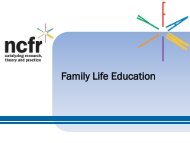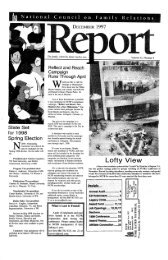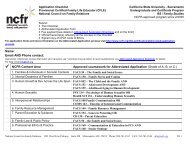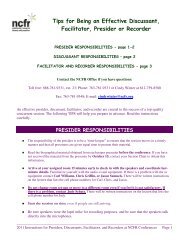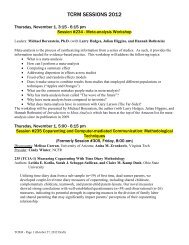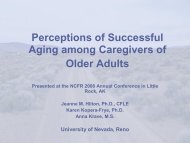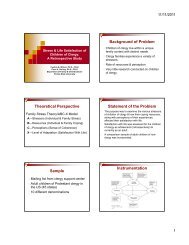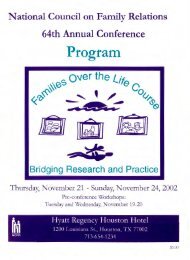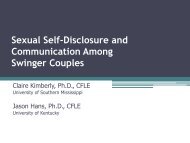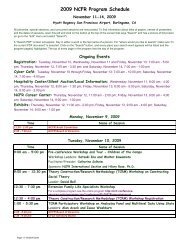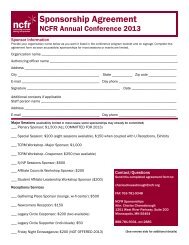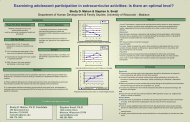Perceived Helpfulness of Four Different Types of Marriage ...
Perceived Helpfulness of Four Different Types of Marriage ...
Perceived Helpfulness of Four Different Types of Marriage ...
You also want an ePaper? Increase the reach of your titles
YUMPU automatically turns print PDFs into web optimized ePapers that Google loves.
<strong>Perceived</strong> <strong>Helpfulness</strong> <strong>of</strong> <strong>Four</strong><strong>Different</strong> <strong>Types</strong> <strong>of</strong> <strong>Marriage</strong>Preparation InterventionsStephen F. Duncan, GenielChilds, & Jeffry H. LarsonSchool <strong>of</strong> Family LifeBrigham Young University
<strong>Marriage</strong> Preparation• <strong>Marriage</strong> preparation is effective• Educational multi-session workshops• Numerous approaches to marriageeducation• Little effort devoted to assessing levels<strong>of</strong> perceived helpfulness acrossdifferent types <strong>of</strong> interventions.
Research Questions• Is the perception <strong>of</strong> helpfulness, volition,length <strong>of</strong> intervention, positive change, andorder <strong>of</strong> interventions related to the gender <strong>of</strong>the participants?• Among participants who participate inpremarital interventions, which one are theymost likely to select first? Of those whoparticipate in more than one premaritalintervention, is there a predictable order <strong>of</strong>interventions, and does this order vary bygender?
Methods• 1,409 respondents completing internet-basedrelationship survey called the RELATionshipEvaluation (RELATE)• Survey added to original RELATE• Relationship education questions includedwhether they have been involved in a class,community/church sponsored workshop,counseling, or in a self-directed learningexperience, designed to help them preparefor marriage
Methods• Of these respondents:• 686 (49%) had participated in a class,• 578 (41%) in a workshop• 411 (29%) in premarital counseling• 746 (53%) in self-directed learning• Asked to indicate how helpful theintervention was in preparing them formarriage
Methods• Asked whether each intervention,compared to before they participated init, resulted in change in 11 areas withdemonstrated importance in predictingmarital satisfaction.• Individual, Couple, and Context areas• Realistic expectations for marriage• Listening to my partner• Family <strong>of</strong> origin influences
Methods• 59.5% female (29) and 39.8% male(31.4)• Mostly well educated, Caucasian,moderate income• 4 (Intervention) X 2 (Gender) repeatedmeasuresmixed model ANOVA
Results - <strong>Helpfulness</strong>• Significant main effect for interventionon the general helpfulness item, F (3,1,583) = 12.01, p=.000• Classes (M=4.15, SD=.89) and selfdirectedmethods (M=4.15, SD=.85) ratedmost helpful, followed by• Community workshops (M=3.95, SD=.89)then• Counseling (M=3.93, SD=1.01).
Results – <strong>Perceived</strong> Change• Significant main effect for types <strong>of</strong>interventions on each <strong>of</strong> the individual,couple, and context measures <strong>of</strong>change• Individual: F(3, 1,533) = 23.31, p = .000• Couple: F(3, 1,590) = 21.80, p=.000• Context: F(3, 1,609) = 22.02, p = .000
Results – <strong>Perceived</strong> Change• Weaker yet significant main effect forgender on each <strong>of</strong> the individual,couple, and contextual measures <strong>of</strong>change• Individual: F(1, 1,340) = 12.94, p = .000• Couple: F(1, 1,333) = 8.06, p=.005• Context: F(1, 1,357) = 13.80, p = .000
Volition and Length <strong>of</strong> Intervention• Significant main effect for volition on theoverall helpfulness <strong>of</strong> the four types <strong>of</strong>interventions, F (2, 2,023) = 3.54,p=.029• Substantial, significant main effect forlength <strong>of</strong> intervention on the overallhelpfulness <strong>of</strong> the four types <strong>of</strong>interventions, F (1, 2,067) = 69.44,p=.000
Volition and Length <strong>of</strong> Intervention• No significant main effects for volitionon any <strong>of</strong> the individual, couple, andcontext positive change measures• Significant main effect for length• Individual: F(1,1,877) = 187.23, p = .000• Couple: F(1, 1,911) = 196.63, p=.000• Context: F(1, 1,918) = 214.51, p = .000
Sequence <strong>of</strong> Interventions• Class: 52.7% selected it first• Workshop: 42.7% selected it first• Premarital counseling: 35.8% selected itfirst• Self-directed learning: 32.3% selected itfirst
Sequence <strong>of</strong> Interventions• 37% reported attending classes first, 25%reported attending counseling first, and 19%each reported their first involvement in eithera workshop or self-directed learning.• Of those who made just one choice, thegreatest proportion chose classes(35%)followed by counseling (30%), workshop(20%) and self-directed (14%) approaches.
Sequence <strong>of</strong> Interventions• If classes chosen first, they were more likely tochoose self-directed learning next, followed byworkshops then counseling.• If counseling was chosen first, they sequenced intoself-directed learning secondly, followed by classesor workshop.• If workshop chosen first, they were more likely tosequence into classes or self-directed approaches.• If self-directed chosen first, they were more likely tosequence into counseling followed by classes.
Summary• All intervention types rated helpful andchange producing, with slightpreference to class and self-directed• <strong>Helpfulness</strong> independent <strong>of</strong> gender• Women consistently reported greaterpositive change than men on individual,couple, and context items.
Implications for <strong>Marriage</strong> Preparation• Preference for moderate intensityinterventions that involve others• Self-directed interventions rivaling, atleast in terms <strong>of</strong> perceived helpfulnessand positive change, more intensiveand structured interventions.• Difficult to recommend one type <strong>of</strong>intervention over another for mostcouples



